Ad networks were one of the first technology platforms introduced to the online display-advertising ecosystem and aimed to help publishers sell inventory not sold via direct buys, which is known as remnant inventory.
Publishers, however, started running into problems when their chosen ad network wasn’t able to sell all of their remnant inventory, which meant their available ad spaces were being left unfilled, leading to missed revenue opportunities.
In an effort to increase fill rates and capitalize on revenue opportunities, a process known as waterfalling started to emerge.
What is Waterfalling?
Waterfalling, also known as a daisy chain or waterfall tags, is a process used by a publisher to sell all remnant inventory. This process occurs when a publisher has been unable to sell its premium ad slots that are usually reserved for direct ad sales between the publisher’s internal sales team and advertisers.
Waterfalling gets its name from the waterfall-like process for selling inventory — i.e. the demand sources are initiated one at a time, one after another.

In the image above, we can see the publisher first tries to sell its inventory via direct sales, as these generally offer the highest cost-per mille (CPM). If it is unable to do so, the publisher will then pass the impression down the waterfall to various ad networks until it is sold.
The advantage of this daisy chain is the publisher is able to sell off its inventory; however, as the impressions go further down the waterfall, the CPM price, which is worked out as an average, decreases.
How is Waterfalling Implemented?
The ad ops team sets up an ad network with a tracking tag that will execute if and when an impression is not filled.
This is typically configured in a field called Fallback Ads, Passbacks, Redirects, Default Ads, and the like.
These passbacks will need to be configured for each ad network used by the publisher. So, referring to the image above, the publisher’s ad ops team would configure the premium ad network to “passback” to the vertical ad network, and so on.
We Can Help You Build a Header Bidding Solution
Our AdTech development teams can work with you to design, build, and maintain a custom-built header bidding solution for any programmatic advertising channel.
How Does Waterfalling Work?
If a publisher has been unable to sell its direct buys, its ad server executes the first ad network’s tag.
There are a couple possible outcomes, so let’s take a look at a few likely scenarios.
Scenario 1
Ad Network #1 is able to provide an impression for this ad call, so it sends an ad back to the user’s browser for display.

Scenario 2
Ad Network #1 isn’t able to provide an impression for this request, so it loads the tag for Ad Network #2, which also fails to provide an impression, so it loads the tag for Ad Network #3, which is able to provide an impression. The impression is sent to the user’s browser and the ad is displayed.

Why didn’t Ad Network #1 or Ad Network #2 provide an impression?
There are a couple possible reasons why these two demand sources didn’t return an impression. These include:
The ad networks may not have had any ads suitable for the website and/or user based on the advertiser’s target criteria. For example, the website could be cooking-focused and the user could be a 40-year-old woman interested in cooking, gardening, and knitting. The ad networks could have ad campaigns targeted towards men between the ages of 20 and 30 interested in sports. The ad networks receive information about the website and user (e.g. the publisher’s URL, geolocation, user demographic, etc.) from the publisher’s ad server, so they are able to decide whether the impression is worth filling.
The publisher’s floor price might have been higher than the price quoted by demand sources. This is not often the case for the first demand sources in the queue, as they are usually ranked from highest average payer to the lowest. See the section below for more details.
The advertisers buying through the ad networks may have set up impression capping, which is often used by advertisers to limit the amount of times their ads are shown to the same person over a set time period. For example, if the advertiser has already displayed the campaign to this user three times, and the capping was set for three impression per 24 hours, then the ad network wouldn’t display the ad to the user despite matching the targeting criteria.
The demand source took too long to reply to the ad request, and was consequently timed out. It could also have experienced some kind of technical failure.
Scenario 3
All demand sources are unable to fill the impression, so the publisher activates its fallback option — an ad promoting its own products or services.

How Does the Ad Server Know Which Ad Network to Load First?
The order in which the ad networks are initiated is generally based on a ranking system set up by the publisher.
Typically, the demand sources will be ranked from highest average historical yield to the lowest. The average historical yield is the average amount of money the demand source has made for the publisher in the past.
However, this does not take into consideration the fact that the highest average historical yield may not be the highest bid at that particular time. It is quite possible that the third-ranked demand source may want to bid a higher amount than the top two sources if the available inventory at a given time matches their targeting criteria.
This essentially means the publisher is selling itself short.
This inability to accurately provide a real-time cost of available impressions has led to the rise of header bidding.

As we can see in the image above, header bidding auctions allow publishers to generate more revenue from their inventory.
Can Supply-Side Platforms (SSPs) Also Utilize Waterfalling?
Traditionally, publishers applied the waterfalling process to ad networks, but publishers soon realized they could apply it to supply-side platforms (SSPs) as well.
However, many are questioning why publishers are doing this, as it essentially means demand sources (e.g. ad exchanges connected via SSPs) could be bidding on the same impression multiple times as the impressions go along the daisy chain.
Advantages and Disadvantages of Waterfalling
Advantages
Sells off remnant inventory: The one main advantage of waterfall auctions is that they allow publishers to sell remnant inventory that would otherwise be wasted.
Easy to implement: Compared to the header bidding process, waterfalling is easier to implement and requires less technical knowledge. In order to implement waterfalling, all the publisher needs to do is set up a tag on an ad network.
Disadvantages
Low yield: As mentioned earlier, the publisher’s ad server chooses the demand sources based on the highest average yield, not the current market price of inventory, meaning the price given is the average CPM, not the true CPM. You can predict based on historical data what the CPM on a given ad network will be — or even negotiate the floor price — but you’re never sure what the final price could actually be. Therefore, you can only set up the waterfall in an optimal way based on the average CPM, which of course may not be optimal for every impression — e.g. a vertical ad network could pay a higher CPM for a certain impression than a premium ad network, but on average, they pay less.
Latency: Loading each tier takes time, and the more time passes, the less likely the user will see the ad.
Errors and timeouts: Each ad network tier may fail to load the fallback or become timed out, resulting in lost revenue.
Manual configurations: Some ad networks require configuring the Passbacks in their system, making it difficult for ad ops to reconfigure and manage.
Waterfalling has been used by many publishers for a number of years, but more and more publishers are moving towards header bidding, mainly because it eliminates many of the disadvantages of waterfalling.
Questions, queries, comments?
Join the conversation about this post on Facebook, Twitter, and LinkedIn.
We Can Help You Build a Header Bidding Solution
Our AdTech development teams can work with you to design, build, and maintain a custom-built header bidding solution for any programmatic advertising channel.








